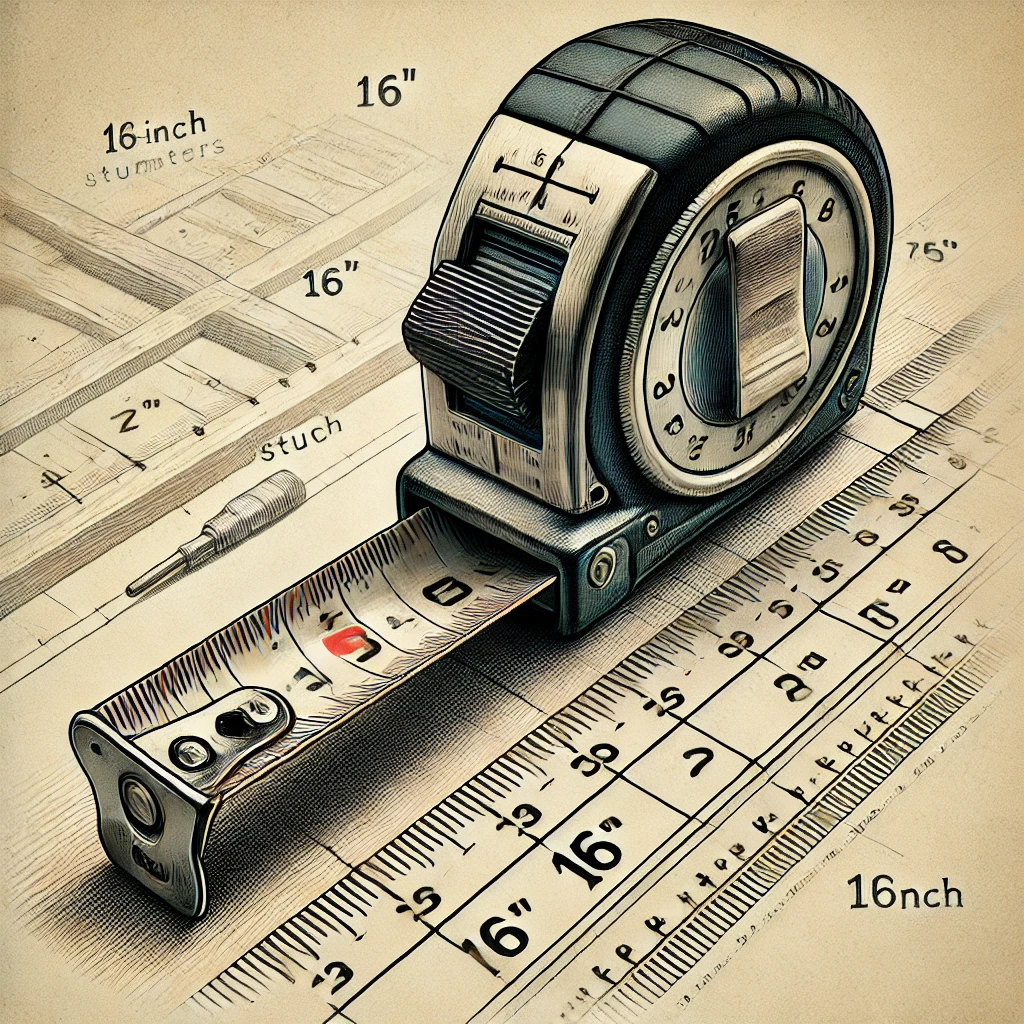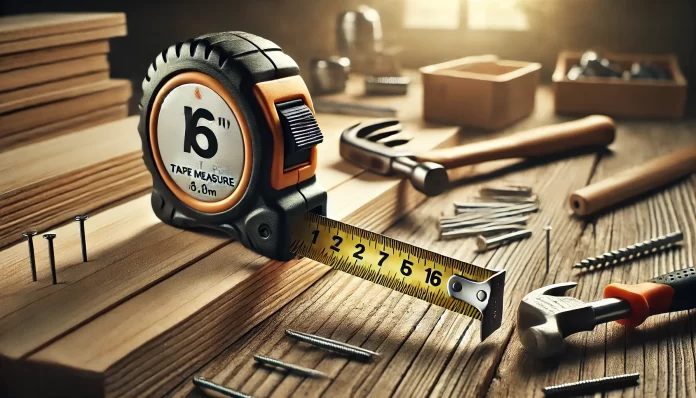Actively read tape when working on do-it-yourself projects or woodworking and home improvement projects to ensure accuracy. Knowing how to read a tape measure is beneficial for placing furniture and saving money. This article teaches about tape measure reading, scales, and taking measurements in various units.
How Do You Read a Tape Measure?
Before learning to read a tape measure, understand the notations for Imperial (inches) and metric (centimetres) scales. Marks on the tape correspond to various fractions of inches. Consequently, the scheme is evident in the metric units; ten millimetres are in one centimetre. These markings are the essentials one must learn about to read a tape measure. When using tape measures, you must understand the measures, the handles, and the scales of the tape measure.
When measuring, understand how to read fractions on standard or metric tape; often asked to convert inches or millimeters when someone requests a measurement.
What Are Tape Measures Used For?
Tape measures are other standard measuring devices used in most situations, ranging from home renovation to building construction. For assembling pieces of furniture, installing pictures or cutting fabrics, one requires an accurate measurement, which is what the series of tape measures provide you with.Most of them have small dimensions, and users can adjust several components so that they do not hinder mobility.
An accurate tape measure is required for this operation, so choose the right one. Measuring parts and pieces is common in many DIY jobs, and woodworking in particular. Thus, to get the right dimensions for your job, you need to learn how to read a tape measure.
How to Use a Tape Measure Correctly?
To use a tape measure, follow the steps below: pull the end of the tape to the required length, then put the metal hook on the end of the object you want to measure. The head of the reader on the tape should lie flat on the surface to give a correct value. When you’ve finished sticking the videotape, look at the nearest mark on the tape, telling you how long it is. If it is in the vertical sense, such as measuring the height of a wall, pull up the hook end of the tape and look at the bottom end for the figures.
When writing a large-scale DIY project, it is important to make measurements twice to be as accurate as possible. Using measuring tape is key, but it has to be the right part, whether the metal hook or the scales and other parts used in taking measurements.

Why Are Tape Measures in Inches and Centimeters?
Measuring tapes measure in imperial units, including inches and feet, and metric units, including centimetres and millimetres, because people use them in diverse places worldwide. While the first one is quite familiar to people in the United States, the second system is standard in Europe. The knowledge of two reference systems will be beneficial because you can apply them to a particular project in civil engineering service.
It is preferable in international projects or where the utilized materials and systems employ one or both units.
What Are the Parts of a Tape Measure?
Tape measures have four components: retractable tape, metal hook, and casing. The metal hook at the end of the tape ensures that the finger can hold it firmly in place while measuring. This makes it easy to calculate since the tape has the markings in inches and centimetres. Rewinding the tape in a manner assists in retaining the roll in the best form and condition in preparation for using it in another endeavour.
All the parts of the tape measure contribute to the goal of accurate measurement: the hook that holds the tape in place and the scales enable one to measure small distances, among others.
How Do You Read Tape Measure Markings?
Understanding the units and divisions on the body of the tape measure makes it easy to read the markings on the tape measure well. Every possible one of the typical measures of length has both the imperial and the metric systems; they usually display both in inches and feet as well as centimetres and Millimeters.
For the imperial system:The most extended numbers on a tape measure refer to the whole inch. Between these inch marks are sub-intervals such as half-inch, quarter-inch, eight-inch and sixteenth-inch. These fractions make it easier to measure if you did measure the large objects and need to adjust to small objects or particular cuts.
For instance, by the time you reach a complete inch line, the second longest line is half an inch, then a quarter-inch, then the eighth of an inch, and so on. In fact, it is very important for anyone who wants to venture into DIY activities to understand how to read these fractions, especially when measuring materials.
For the metric system:He stated that for each centimetre, there are ten millimetres, five large lines equal one centimetre, and the tiny lines represent millimetres. Tape measures that utilize digits are ten times easier to read than fractions.
For instance, if a measurement partially falls between two centimetre marks, you make a calculation based on the millimetre scale.
Knowledge of these tape measure markings will help you understand two systems at one point, whether at home or in a furniture-making project, a construction site, or a crafting process.
What Tips Should You Follow for Accurate Measurement?
Measurement is an intercalary piece; any work that lacks it is incomplete. Here are some expert tips to help you get precise results every time:
Hold the Tape Flat: It is essential to ensure the tape is right on the object’s body in case of measurements. Bending or twisting the tape can cause the presented measurements to be imprecise. Pull the tape straight away from the wall when measuring vertically.
Use the Metal Hook Correctly: The metal hook as the end of the tape is slightly flexible enough to accommodate the thickness of the hook. If you are measuring around the inside of an object (for example, a drawer), put the hook to the edge. When measuring the outside of something, hook it around the object you are measuring. This minor adjustment helps one get the correct measurements.
Measure Twice, Cut Once: Oh yes, this old adage is still one of the most important tips one could have. The best practice is to always ensure that you take measurements on your material more than twice before you begin actual cutting. This helps to minimize the embarrassment of making wrong estimates that might lead to the wastage of resources or time in the project.
These tips should help you achieve the highest possible level of accuracy with each measurement, avoiding costly errors that could cause a project to go wrong.
Why Are Studs Marked on Tape Measures?
Most manufacturers mark tape measures differently to show the number of inches between the wall studs—usually 16″. These stud markings are very important, especially when constructing a home, hanging frames, or hanging heavy items on a wall.
- 16-Inch Intervals: Most homes are framed with studs spaced 16 inches apart in the centre for wall construction. These marks on the tape measure are helpful when installing drywall, framing a wall, hanging shelves, or even hanging heavy pictures. Instead of getting another tool to identify the stud’s location, you can do it by completing these measurements quickly.
- Black Diamonds: There will be another bunch of premium features, and one of these may include minor black diamond signs on some of the tape measures. Placing these every 19.2 inches and using them in commercial construction or any big project that uses gaps between the studs differs from standard construction.
By employing these stud markings, one can confidently ensure that they have fixed and supported their project well.
What Is Metric Measuring and How Do You Read a Metric Tape Measure?
The metric system bases metric measuring on everything being divided into tens, making it more accessible than the imperial system. In the metric tape measure, the central distinguishing unit of measurement is centimetres; for each centimetre, there are 10 millimetres. This makes it easy to exercise unparalleled measurement accuracy without fraction computations.
- Reading a Metric Tape Measure: If you were to read a metric tape, first try to level off on the nearest whole centimetre graduation. If you fall between two-centimetre lines while measuring, look closer at the millimetre lines to get your length. For example, if a measured object drops 7 millimetres after the 5th-centimeter mark, it is 5.7 centimetres.
- Converting Between Metric and Imperial: Some Tape measures come with dual dimensions, imperial and metric, and you can choose which one to use depending on the job. While you are using the tape measure, you can find the standard unit of measurement at the bottom.Check the tape measure for the needed unit when working with various materials or different units. The metric system is widely used globally in areas like science, engineering, and medicine.
Metric units are precise because they are based on the decimal point, and reading a metric measuring tape is more accessible than that of imperial measuring tools. Smart Lock : The Benefits of Home Automation
How Can You Maintain Your Tape Measure for Longevity?
If you want your measuring tape to work year after year, then you need to follow some basic rules of its care. Here are a few tips:
- Retract the Tape Carefully: Pull it slowly to avoid damaging the metal hook, which is used to pull the Tape back into the casing or forcefully. In some cases, fast retracting results in bending or breaking the Tape or misalignment of the hook, which is useful for subsequent measurements.
- Store in a Dry Place: In some cases, damp environments cause the metal hook and blade of the tape measure to rust. When using a metal tongue and groove, please make sure you store your tape measure somewhere dry because moisture might cause it to rust.
- Clean the Tape Regularly: If your measure tape is dusty, painted or tainted by other materials, you should clean it using a cloth. Prevent dirt from getting into the casing because it will interfere with the free movement of the tape and may also obscure the markings, reducing accuracy in the long run.
- Check the Metal Hook:A metal hook may become weak or broken after some time because it is used instead of a rigid and robust plastic one, probably due to regular bending into the slot. Ensure that the back hook is compelling and moves as needed for inside and outside calibration.
By following the above maintenance measures, you will ensure that your tape measure serves you well and also produces accurate results on your various projects.The Rise of Beluga: The Cat Behind the Meme
Bullet Point Summary
- Learn the details of how a tape measure is read and marked.
- Find out how different shapes and sizes of tape measures are used in DIY and professional projects.
- Use suitable methods of measurement to yield the correct measurements.
- Make yourself acquaintances with the imperial and metric systems of measurement.
- Take care of your tape measure if you want it to last longer.
By mastering these key concepts, you’ll be able to handle any measurement task with confidence and precision!
FAQ
What is a tape measure and how do I use it?
A versatile measuring tool that can bend in such a way that makes it easy to be used for any kind of project including home improvement or constructions . It is normally collapsible so that you can pull out to take a measurement and keep retracting it when done. Basically, using a tape measure doesn’t require much hassle; all one has to do is, pull out the hook to the end of the tape and align it against what you wish to measure. Simple as that, right?
How do I read a tape measure correctly?
It may sound strange or even impossible to read a tape measure but once you’ve mastered it then it is very easy. As with any measurement, the respective lines are drawn differently. Longer lines represent the whole inch; short lines represent other measures such as half inch, quarter inch and even eighth of an inch. If you are using a metric tape measure, what you will observe on the scale is centimeter and millimeter markings. Oh yeah, one important thing to understand: to get the reading always start at the end of the tape!
What are the different units of measurement on a tape measure?
Tape measures usually come in two types of units: The above is a list of units in two main classifications which are the imperialism system and the metric system. The imperial units use inch and feet while the metric units using centimeters and millimeters. If you like inches and metric measurements you are in luck because many tape measures contain both!
Why is it important to make sure you measure accurately?
It is important to receive the best measurement possible, especially in case of home improvement projects where every extra millimeter, or inch matters! If you are not accurate it may ruin everything from putting up book shelves to putting down a new floor. Furthermore, nobody wants to spend extra time in revising some work because of some silly error!


